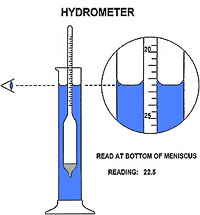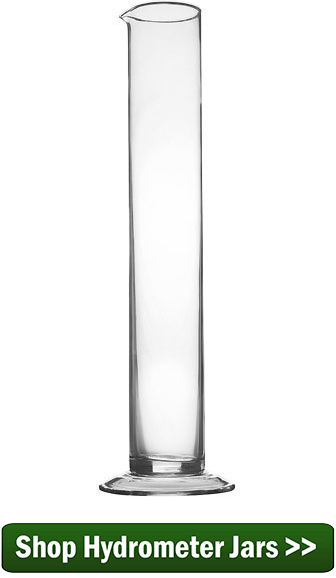 Do you really need to own a hydrometer? If you want to know the alcohol content of your beer, wine, mead, or cider – then yes! Or, if you want to know how your fermentation is coming along – then yes! Here’s instructions on how to use a hydrometer for brewing beer and how to determine the alcohol of your beer.
Do you really need to own a hydrometer? If you want to know the alcohol content of your beer, wine, mead, or cider – then yes! Or, if you want to know how your fermentation is coming along – then yes! Here’s instructions on how to use a hydrometer for brewing beer and how to determine the alcohol of your beer.
What is a hydrometer and how does it work?
A hydrometer is a simple device that helps home brewers and winemakers determine the alcohol content of their beer and wine. It’s a glass tube with a weight on the bottom and it floats in a sample of wort, must, beer, or wine. Based on how high or low the hydrometer floats, we can determine the amount of sugar suspended in the liquid. By taking one reading before fermentation and one reading after, we can easily measure how much sugar was consumed by the yeast and converted into alcohol.
How to take a proper hydrometer reading
To take a hydrometer reading, collect a sample of wort or beer into a graduated cylinder or hydrometer testing jar. Some homebrewers use the tube that the hydrometer comes in, but they’re really not made for this purpose, and that’s not a recommended way to use a hydrometer.
Carefully suspend the hydrometer in the sample and give it a spin to shake off any bubbles. When it slows, read the measurement (in the form of 1.0xx). Remember, if you want to return the wort or beer to the fermenter, the testing cylinder and the hydrometer should both be sanitized.
There are two keys to taking an accurate hydrometer reading:
- You must take the reading at the level of the top of the liquid sample. Liquids will “climb” up the side of the hydrometer due to the surface tension of the liquid, so measure from the level of the liquid, not where the liquid sticks to the hydrometer (see diagram).
- You must either take the reading at the appropriate temperature, or correct for the difference in temperature.

To expand on the second point, every hydrometer is calibrated for a certain temperature, usually 60 or 68 degrees Fahrenheit. I suggest chilling your wort or beer sample by running it under cold water or sticking it in the freezer – just don’t forget about it! Once you’re relatively close to the calibration temperature, just plug the values into a calculator such as this one to adjust the reading.
How to use a hydrometer to calculate alcohol content
To calculate alcohol content, take one hydrometer reading before fermentation (prior to pitching yeast) and one reading after fermentation. Multiply the difference between the two readings by 131.25.
Example:
Starting gravity (SG) = 1.060
Final gravity (FG) = 1.010
1.060 – 1.010 = 0.050
0.050 * 131.25 = 6.56% ABV (alcohol by volume)
Alternatively, you can do the same calculation with gravity points.
 For example: 1.060 = 60 gravity points; 1.010 = 10 gravity points
For example: 1.060 = 60 gravity points; 1.010 = 10 gravity points
60 – 10 = 50
50 * .13125 = 6.56% ABV
While using a hydrometer to measure alcohol makes it important enough to have, by itself, the hydrometer is also valuable for tracking fermentations and for verifying that a fermentation has completed once that activity has topped. There such a thing as stuck fermentations that need to be looked out for.
So, that’s all there is to it! That’s how to use a hydrometer. The explanation gets a little technical, but after a couple tries you’ll have a handle on reading hydrometers in no time!
—–
David Ackley is a beer writer, brewer, and self-described “craft beer crusader.” He holds a General Certificate in Brewing from the Institute of Brewing and Distilling and is founder of the Local Beer Blog.

Is there any way to check th alcohol content on finished wine if you did not take a reading ay the beginning?
Why does no one recommend the Honneyman method? When run just before bottling, you don’t have to worry about backsweetening or other additives. And it is just as accurate as the above method.
need to know information: thanks making 15g wine this year
Barryjo, basically because it is more work than taking two readings with a hydrometer… one before and one after the fermentation.
Barbara, there are ways to check a finish wine, however they are not that practical for the home winemaker. Accuracy is an issue as well. You can try using a Vinometer, but residual sugars in the wine can throw the reading off… sometimes dramatically. You can try the Honneyman method mentioned earlier, but it requires taking very fine readings with a hydrometer.
@Barbara McHone & mr Mikey: The Honneyman method can be found at http://www.fermcalc.com. Near the bottom of the article. It uses 2 readings and a chart to determine abv.
@Customer service: Only if you remember to take the first reading!!! I seem to have a problem with that.
And for most amateur wine makers, being close in the abv is sufficient. Plus or minus 1/2% abv.Others who have to know the exact abv can do the "before and after", or buy an ebulliometer.
Pingback: How to Know When to Bottle Your Homebrew Beer | Beer Brewing and Wine Making Blog | EC Kraus
Excellent article, David Ackley does a great job explaining these matters.
Could you not just weigh your fermentor before and after and calculate the difference. If 2kg of sugar have turned to co2 it’ll be 2kg lighter at the end.
This is a possibility to get you in the ball park, so it can work to some degree. But there are variables involved. When you add 2kg of sugar, roughly half the weight will turn to CO2 gas. The other half will turn to alcohol. But it is not perfectly half. Different types of beer yeast will ferment differently, 48%/52% or 53%/47% ratio, for example. The nutrients available to the yeast from the recipe play into it as well. So even the exact same beer yeast can ferment differently between batches. The second variable is evaporation which is somewhat self-explanatory.